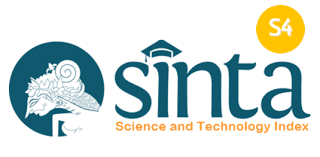ANTIBACTERIAL EFFECTIVENESS OF MORINGA LEAF EXTRACT GEL FORMULATION AGAINST PROPIONIBACTERIUM ACNES
Abstract
Moringa oleifera Lam, lebih sering disebut sebagai tanaman kelor di Indonesia, adalah contoh tanaman yang memiliki potensi signifikan yang belum dimanfaatkan untuk digunakan dalam industri farmasi. Daun pohon kelor menyediakan berbagai nutrisi penting, termasuk energi, protein, lemak, karbohidrat, serat makanan, dan berbagai vitamin dan mineral. Bubuk daun kelor memiliki konsentrasi sitokinin yang tinggi, salah satunya adalah zeatin, molekul dengan sifat anti-oksidan yang kuat serta sifat anti-penuaan dan anti-inflamasi. Jerawat disebabkan oleh bakteri Propionibacterium acnes, yang dapat ditemukan di kulit (acne vulgaris). Tujuan dari penelitian ini adalah untuk melihat apakah gel ekstrak etanolik yang terdapat pada kelor mengandung sifat antibakteri yang dapat membantu menghentikan pertumbuhan bakteri Propionibacterium acnes. Model in vitro digunakan dalam jenis penelitian ini, yang dilakukan di laboratorium. Desain penelitian adalah True Experimental Post-Test Group Design, dan jumlah hewan uji sebanyak 28 ekor. Hewan uji dibagi menjadi tujuh kelompok, dengan masing-masing kelompok menerima terapi yang berbeda. SPSS digunakan untuk menganalisis informasi yang diperoleh. Hasil penelitian menunjukkan bahwa formulasi gel ekstrak daun kelor berpengaruh konsisten terhadap pertumbuhan bakteri Propionibacterium acnes, dengan rata-rata diameter zona hambat 14,5 mm (efektifitas kuat) pada metode sumuran dan 13,0 mm (efektifitas kuat) pada metode sumuran. difusi cakram metode sumur. Temuan menunjukkan bahwa formulasi gel mengurangi pertumbuhan bakteri Propionibacterium acnes secara konsisten. Jika dibandingkan dengan konsentrasi lain, aksi antibakteri ekstrak etanol gel daun kelor memiliki daya hambat paling tinggi saat menggunakan teknik sumuran pada konsentrasi 20%, dan saat menggunakan metode difusi cakram pada konsentrasi 40%.
Kata Kunci : gel ekstrak daun kelor; Propionicacterium acnes
Abstract
Moringa oleifera Lam, more commonly referred to as Moringa plant in Indonesia, is an example of a plant that has significant untapped potential for use in the pharmaceutical industry. Moringa leaves are the most widely used plant parts by the community. Moringa tree leaves provide a variety of essential nutrients, including energy, protein, fat, carbohydrates, dietary fiber, and various vitamins and minerals. Moringa leaf powder has a high concentration of cytokinins, one of which is zeatin, a molecule with strong anti-oxidant properties as well as anti-aging and anti-inflammatory properties. Cytokinins are also found in Moringa leaf powder. Acne is caused by the bacterium Propionibacterium acnes, which can be found on the skin (acne vulgaris). Propionibacterium acnes is a strain of bacteria that can cause infection. The purpose of this study was to see whether the ethanolic extract gel contained in Moringa contains antibacterial properties that can help stop the growth of Propionibacterium acnes bacteria. In vitro models are used in this type of research, which is carried out in a laboratory. The research design was True Experimental Post-Test Group Design, and the number of test animals was 28. The test animals were divided into seven groups, with each group receiving a different therapy. SPSS is used to analyze the information obtained. The results showed that the gel formulation of Moringa leaf extract had a consistent effect on the growth of Propionibacterium acnes bacteria, with an average inhibition zone diameter of 14.5 mm (strong effectiveness) in the well method and 13.0 mm (strong effectiveness) in the well method. disc diffusion well method. The findings showed that the gel formulation reduced the growth of Propionibacterium acnes bacteria consistently. When compared with other concentrations, the antibacterial action of the ethanolic extract of Moringa leaf gel had the highest inhibition when using the well technique at a concentration of 20%, and when using the disc diffusion method at a concentration of 40%.
Keywords: Moringa leaf extract gel; Propionicacterium acnes
Full Text:
PDFReferences
Edy, Hosea J, Parwanto, Mauritius L. Pemanfaatan Tanaman Tagets erecta Linn. Dalam Kesehatan. Biomed dan Kesehat. 2019;2(2).
Pandey A. Moringa oleifera Lam. (Sahijan) - a plant with a plethora of diverse therapeutic benefits: an update retrospection. Med Aromat Plants. 2012;1(1):2-8.
Ginarana A, Warganegara E, Oktafany. Uji Aktivitas Antibakteri Formulasi Gel Ekstrak Daun Kelor (Moringa oleifera) terhadap Staphylococcus aureus. J Major. 2020;9(2):21-5.
Krisnadi AD. Kolor, Super Nutrisi. Blora: Kelorina.com. 2015.
A. Dudi K. Kolor, Super Nutrisi. In: Blora: Pusat Informasi dan Pengembangan Tanaman Kelor Indonesia. 2015.
Yusuf A, Nurawaliah E, Harun N. Uji efektivitas gel ekstrak etanol daun kelor (Moringa oleifera L.) sebagai antijamur Malassezia furfur. Kartika J Ilmu Farm. 2017;5(2):62-7.
Posangi I, Posangi J, Wuisan J. Efek ekstrak daun sirsak (Annona muricata L.) pada kadar kolesterol total tikus wistar. J Biomedik. 2012;4(1):37-42.
Mhaske M, Samad BN, Jawade R, Bhansali A. Chemical Agents in Control of Dental Plaque in Dentistry: An Overview of Current Knowledge and Future Challenges. Pelagia Res Libr. 2012;3(1):268-72.
Suteja I, Rita W, Gunawan I. Identifikasi dan Uji Aktivitas Senyawa Flavonoid Dari Ekstrak Daun Trembesi (Albizia saman (Jacq.) Merr) Sebagai Antibakteri Escherichia coli. J Kim. 2016;10(1):141-8.
Yuniar H, Rahmawati, Rousdy D. Efektivitas Antimikroba Buah Lakum (Cayratia trifolia [L.] Domin ) Terhadap Pertumbuhan Bakteri Streptococus sp. (L.10.3). J Protobiont. 2020;9(1):73-7.
Setianti S, Lukmayani Y, Syafnir L. Kajian Pustaka Aktivitas Antibakteri Ekstrak Daun Kelor ( Moringa oleifera Lam .) terhadap Bakteri Penyebab Jerawat. In: Prosiding Farmasi. 2021. p. 170-4.
Hafsari A, Cahyanto T, Sujarwo T, Lestari R. Uji aktivitas antibakteri ekstrak daun beluntas (Pluchea indica (L.) Less. ) terhadap propionibacterium acnes penyebab jerawat. In: Skripsi. 2015. p. 141-61.
DOI: https://doi.org/10.35971/jjhsr.v4i3.15025
Refbacks
- There are currently no refbacks.

This work is licensed under a Creative Commons Attribution-ShareAlike 4.0 International License.
Jambura Journal of Health Sciences and Research is licensed under a Creative Commons Attribution-ShareAlike 4.0 International License
</p



_.png)




_edit.png)




